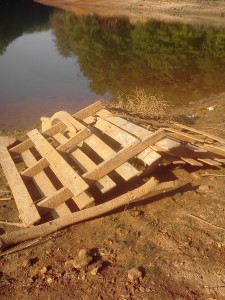When we posted the 2012 FLW Tour schedule a while back, I was understandably excited. After all, the big day is going to be happening in my back yard.
Not long after that article, I took a trip out to Lake Lanier to target some Spotted Bass. Because the water level was so low at the time, I was able to get a few pictures of some things that not a whole lot of people know about. Lake Lanier features man-made structure piles specifically so bass can congregate and ambush their prey.
Obviously, these are going to be fantastic places to fish, as they provide everything a bass would ever need. In fact, if we go back in time a little more than a year, we will see just how productive these little brush piles can be.
The 2010 Forrest Wood Cup
In 2010, Kevin Hawk narrowly qualified for the Forrest Wood Cup. Knowing that the tournament would be held on Lake Lanier, he made a bold move.
He decided to pack his bags, and move to Georgia 9 months ahead of the tournament so he could practice all day every day. He found a place for rent on Craigslist, threw everything he could in his truck and boat, and made the 2,500 mile drive across country.
He still fished on the FLW Tour during this time, but did so as a co-angler. All told, he was fishing 4-5 days a week on Lanier, specifically searching out these man-made brush piles. And it payed off!
On the final day, when his closest competitors barely cracked double digit bags, Hawk weighed in 14lbs. 13 oz.
His strategy was to run and gun from brush pile to brush pile—spending no more than 7 minutes at a spot.
The Lake Lanier Brush Piles
By now, you are probably curious as to what these brush piles look like. Check out the picture on the right. I was able to get this photo
because the lake levels were down on a recent trip.
Of course, they don’t all look this way, but most of them are intentionally placed in such a way as to create a perfect place for bass to hide, live, and ambush their prey. They will also attract a lot of sunfish, which the bigger bass will eat just as happily as they will a blue-back herring.
When Kevin Hawk moved from California to Georgia in preparation for the Cup, we new about these piles. He spent months and months, and hours and hours on the water finding as many of these as he could find.
He was the only angler on the water following this strategy—a strategy he developed from months and months of dedicated practice.
It is safe to say that as much research goes into being a successful angler as anything else. These aren’t just a bunch of guys drinking beers and fishing all day—they are dedicated to the sport, and they work hard to get the success they have.
Other Man Made Brush Piles
Guess what? Lake Sidney Lanier is not the only lake in the world that features these types of man-made structures. Lots of lakes, maybe some you’ve fished time and again, have this kind of structure.
For as long as people have been fishing, there have been a group of people trying to preserve fishing for the next generation, and helping mother nature help anglers is a good way to do that.
Do a Google search of your favorite lake. Look for anything you can find. Search for man-made structure, or anything else that is published that would help fish hold, and attack their prey.
When I did this, I found the Blueridge Resevoir (one of my favorite local smallmouth fisheries) had at least 20 man-made structures consisting of large plastic tubing and other items. They are like jungle gyms for fish!
Finding these in your local lake, whether you fish in tournaments or not, will help you have a lot more fun on the water, and catch a ton more fish!
